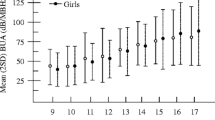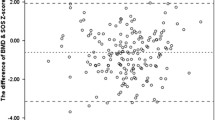Abstract
Few studies have shown comparison data between calcaneus stiffness index (SI) calculated by quantitative ultrasound (QUS) and bone mineral density (BMD) measured by dual-energy X-ray absorptiometry (DXA) in the Chinese population. This study was aimed to examine the correlations between calcaneus SI calculated by QUS and total body BMD and bone mineral content (BMC) measured by DXA in Chinese children and adolescents. We measured the total body BMD and BMC using Lunar Prodigy (GE Healthcare), and speed of sound (SOS), broadband ultrasound attenuation (BUA), and a calculated SI of the left os calcis using Lunar Achilles Express (GE Healthcare) in 392 healthy Chinese schoolchildren and adolescents aged 5–19 years. The short-term precision for DXA was 0.5 % for total body BMD. The precision for QUS was 1.8 % for SI, 2.9 % for BUA, and 0.4 % for SOS. Pearson’s correlation coefficients (r) were calculated to assess the possible correlations between the total body BMC by DXA and SI calculated by QUS. There were significantly positive correlations between SI of the left os calcis and total body BMD (r = 0.693, p < 0.001, n = 392) and BMC (r = 0.690, p < 0.001, n = 392). For all the subjects, significant positive correlations were observed between the calcaneal SI and the age, weight, height, BMI, total body BMD, total body BMC, total body lean mass, and total body fat mass, with r ranging from 0.310 (total body fat mass) to 0.693 (total body BMD) (p < 0.001, n = 392). In conclusion, QUS bone densitometry is a useful measuring method showing the physiological bone development in childhood and adolescence.


Similar content being viewed by others
References
Gilsanz V (1998) Bone density in children: a review of the available techniques and indications. Eur J Radiol 26:177–182
Specker BL, Schoenau E (2005) Quantitative bone analysis in children: current methods and recommendations. J Pediatr 146:726–731
Binkovitz LA, Henwood MJ, Sparke P (2008) Pediatric DXA: technique, interpretation and clinical applications. Pediatr Radiol 38(suppl 2):S227–S239
Binkley TL, Berry R, Specker BL (2008) Methods for measurement of pediatric bone. Rev Endocr Metab Disord 9:95–106
Leib ES, Lewiecki EM, Binkley N, Hamdy RC (2004) Official positions of the International Society for Clinical Densitometry. J Clin Densitom 7:1–6
Njeh CF, Boivin CM, Langton CM (1997) The role of ultrasound in the assessment of osteoporosis: a review. Osteoporos Int 7:7–22
Gregg EW, Kriska AM, Salamone LM, Roberts MM, Anderson SJ, Ferrell RE, Kuller LH, Cauley JA (1997) The epidemiology of quantitative ultrasound: a review of the relationship with bone mass, osteoporosis and fracture risk. Osteoporos Int 7:89–99
Baroncelli GI (2008) Quantitative ultrasound methods to assess bone mineral status in children: technical characteristics, performance, and clinical application. Pediatr Res 63:220–228
Massie A, Reid DM, Porter RW (1993) Screening for osteoporosis: comparison between dual-energy x-ray absorptiometry and broadband ultrasound attenuation in 1000 perimenopausal women. Osteoporos Int 3:107–110
Faulkner KG, McClung MR, Coleman LJ, Kingston-Sandahl E (1994) Quantitative ultrasound of the heel: correlation with densitometric measurements at different skeletal sites. Osteoporos Int 4:42–47
Tromp AM, Smit JH, Deeg DJH, Lips P (1999) Quantitative ultrasound measurements of the tibia and calcaneus in comparison with DXA measurements at various skeletal sites. Osteoporos Int 9:230–235
Jaworski M, Lebiedowski M, Lorenc RS, Trempe J (1995) Ultrasound bone measurement in pediatric subjects. Calcif Tissue Int 56:368–371
Sundberg M, Gardsell P, Johnell O, Ornstein E, Sernbo I (1998) Comparison of quantitative ultrasound measurements in calcaneus with DXA and SXA at other skeletal sites: a population-based study on 280 children aged 11–16 years. Osteoporos Int 8:410–417
Lum CK, Wang MC, Moore E, Wilson DM, Marcus R, Bachrach LK (1999) A comparison of calcaneus ultrasound and dual X-ray absorptiometry in healthy North American youths and young adults. J Clin Densitom 2:403–411
Alwis G, Rosengren B, Nilsson JA, Stenevi-Lundgren S, Sundberg M, Sernbo I, Karlsson MK (2010) Normative calcaneal quantitative ultrasound data as an estimation of skeletal development in Swedish children and adolescents. Calcif Tissue Int 87:493–506
Hans D, Dargent-Molina P, Sebert JL, Schott AM, Cormier C, Kotzki PO, Delmas PD, Pouilles JM, Breart G, Meunier PJ (1996) Ultrasonographic heel measurements to predict hip fracture in elderly women: the EPIDOS prospective study. Lancet 348:511–514
Sakata S, Kushida K, Yamazaki K, Inoue T (1997) Ultrasound bone densitometry of os calcis in elderly Japanese women with hip fracture. Calcif Tissue Int 60:2–7
Arabi A, Nabulsi M, Maalouf J, Choucair M, Khalifé H, Vieth R, El-Hajj Fuleihan G (2004) Bone mineral density by age, gender, pubertal stages, and socioeconomic status in healthy Lebanese children and adolescents. Bone (NY) 35:1169–1179
Cromer BA, Binkovitz L, Ziegler J, Harvey R, Debanne SM (2004) Reference values for bone mineral density in 12- to 18-year-old girls categorized by weight, race, and age. Pediatr Radiol 34:787–792
Ward KA, Ashby RL, Roberts SA, Adams JE, Zulf Mughal M (2007) UK reference data for the Hologic QDR Discovery dual-energy x-ray absorptiometry scanner in healthy children and young adults aged 6–17 years. Arch Dis Child 92:53–59
Zanchetta JR, Plotkin H, Alvarez Filgueira ML (1995) Bone mass in children: normative values for the 2–20-year-old population. Bone (NY) 16:S393–S399
Lazcano-Ponce E, Tamayo J, Cruz-Valdez A, Díaz R, Hernández B, Del Cueto R, Hernández-Avila M (2003) Peak bone mineral area density and determinants among females aged 9 to 24 years in Mexico. Osteoporos Int 14:539–547
Goksen D, Darcan S, Coker M, Kose T (2006) Bone mineral density of healthy Turkish children and adolescents. J Clin Densitom 9:84–90
Xu H, Chen JX, Gong J, Zhang TM, Wu QL, Yuan ZM, Wang JP (2008) Normal reference for bone density in healthy Chinese children. J Clin Densitom 10:266–275
Mughal MZ, Ward K, Qayyum N, Langton CM (1997) Assessment of bone status using the contact ultrasound bone analyser. Arch Dis Child 76:535–536
Bonjour JP, Theints G, Buchs B (2001) Critical years and stages of bone mass. Horm Res 4:147–157
Manzoni P, Brambilla P, Pietrobelli A, Beccaria L, Bianchessi A, Mora S, Chiumello G (1996) Influence of body composition on bone mineral content in children and adolescents. Am J Clin Nutr 64:603–607
Felson DT, Zhang Y, Hannan MT, Anderson JJ (1993) Effects of weight and body mass index on bone mineral density in men and women: the Framingham study. J Bone Miner Res 8:567–573
Crabtree NJ, Kibirige MS, Fordham JN, Banks LM, Muntoni F, Chinn D, Boivin CM, Shaw NJ (2004) The relationship between lean body mass and bone mineral content in paediatric health and disease. Bone (NY) 35:965–972
Hogler W, Briody J, Woodhead HJ, Chan A, Cowell CT (2003) Importance of lean mass in the interpretation of total body densitometry in children and adolescents. J Pediatr 143:81–88
Valdimarsson O, Kristinsson JO, Stefansson SO, Valdimarsson S, Sigurdsson G (1999) Lean mass and physical activity as predictors of bone mineral density in 16–20-year old women. J Intern Med 245:489–496
Pietrobelli A, Faith MS, Wang J, Brambilla P, Chiumello G, Heymsfield SB (2002) Association of lean tissue and fat mass with bone mineral content in children and adolescents. Obes Res 10:56–60
Ogle GD, Allen JR, Humphries IR, Lu PW, Briody JN, Morley K, Howman-Giles R, Cowell CT (1995) Body-composition assessment by dual-energy x-ray absorptiometry in subjects aged 4–26 years. Am J Clin Nutr 61:746–753
Ellis KJ, Abrams SA, Wong WW (1998) Body composition reference data for a young multiethnic female population. Appl Radiat Isot 49:587–588
Sioen I, Mouratidou T, Herrmann D, De Henauw S, Kaufman JM, Molna′r D, Moreno LA, Marild S, Barba G, Siani A, Gianfagna F, Tornaritis M, Veidebaum T, Ahrens W (2012) Relationship between markers of body fat and calcaneal bone stiffness differs between preschool and primary school children: results from the IDEFICS baseline survey. Calcif Tissue Int 91:276–285
Sawyer A, Moore S, Fielding K, Nix D, Kiratli J, Bachrach L (2001) Calcaneus ultrasound measurements in a convenience sample of healthy youths. J Clin Densitom 4:111–120
Zebaze R, Brooks E, High M, Duty E, Bronson W (2003) Reproducibility of heel ultrasound measurement in prepubescent children. J Ultrasound Med 22:1337–1340
Kang C, Speller R (1998) Comparison of ultrasound and dual energy X-ray absorptiometry measurements in the calcaneus. Br J Radiol 71:861–867
Greenspan S, Bouxsein M, Melton M, Kolodny A, Clair J, Delucca PT, Stek M Jr, Faulkner KG, Orwoll ES (1997) Precision and discriminatory ability of calcaneal bone assessment technologies. J Bone Miner Res 12:1303–1313
Alenfeld F, Engelke K, Schmidt D, Brezger M, Diessel E, Felsenberg D (2002) Diagnostic agreement of two calcaneal ultrasound devices: the Sahara bone sonometer and the Achilles+. Br J Radiol 75:895–902
Economos CD, Sacheck JM, Wacker W, Shea K, Naumova EN (2007) Precision of Lunar Achilles + bone quality measurements: time dependency and multiple machine use in field studies. Br J Radiol 80:919–925
Schwartz DA, Connolley CD, Koyama T, Wise PE, Herline AJ (2005) Calcaneal ultrasound bone densitometry is not a useful tool to screen patients with inflammatory bowel disease at high risk for metabolic bone disease. Inflamm Bowel Dis 11:749–754
Rossini M, Viapiana O, Del Marco A, de Terlizzi F, Gatti D, Adami S (2007) Quantitative ultrasound in adults with cystic fibrosis: correlation with bone mineral density and risk of vertebral fractures. Calcif Tissue Int 80:44–49
Christoforidis A, Perifanis V, Papadopoulou E, Dimitriadou M, Kazantzidou E, Vlachaki E, Tsatra I (2009) Poor correlations between measurements of bone quality by quantitative ultrasound sonography and dual energy X-ray absorptiometry in patients with beta-thalassaemia major. Eur J Haematol 82:15–21
Christoforidis A, Economou M, Papadopoulou E, Kazantzidou E, Farmaki E, Tzimouli V, Tsatra I, Gompakis N, Athanassiou-Metaxa M (2011) Comparative study of dual energy X-ray absorptiometry and quantitative ultrasonography with the use of biochemical markers of bone turnover in boys with haemophilia. Haemophilia 17:e217–e222
Williams JE, Wilson CM, Biassoni L, Suri R, Fewtrell MS (2012) Dual energy x-ray absorptiometry and quantitative ultrasound are not interchangeable in diagnosing abnormal bones. Arch Dis Child 97:822–824
Cortet B, Boutry N, Dubois P, Legroux-Gerot I, Cotten A, Marchandise X (2004) Does quantitative ultrasound of bone reflect more bone mineral density than bone microarchitecture? Calcif Tissue Int 74:60–67
van den Bergh JP, Noordam C, Ozyilmaz A, Hermus AR, Smals AG, Otten BJ (2000) Calcaneal ultrasound imaging in healthy children and adolescents: relation of the ultrasound parameters BUA and SOS to age, body weight, height, foot dimensions and pubertal stage. Osteoporos Int 11:967–976
Acknowledgments
The authors express their gratitude to all participating children and their parents. The authors also gratefully acknowledge Mr. Jin-Qiu Xie for excellent technical support. This study was funded in part by the Undergraduate Science Innovation Project of Jinan University (No. 1210559031).
Conflict of interest
None of the authors have any personal or financial conflicts of interest.
Author information
Authors and Affiliations
Corresponding author
About this article
Cite this article
Xu, Y., Guo, B., Gong, J. et al. The correlation between calcaneus stiffness index calculated by QUS and total body BMD assessed by DXA in Chinese children and adolescents. J Bone Miner Metab 32, 159–166 (2014). https://doi.org/10.1007/s00774-013-0474-5
Received:
Accepted:
Published:
Issue Date:
DOI: https://doi.org/10.1007/s00774-013-0474-5




